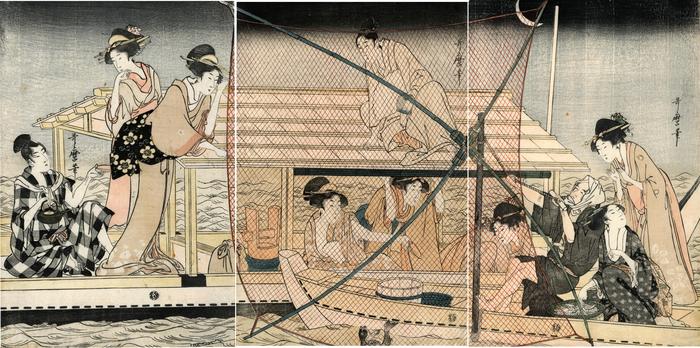Kitagawa Utamaro (喜多川歌麿) (artist ca 1753 – 1806)
Fishing with a four armed scoop-net (yotsude ami - 四つ手網) by the light of a crescent moon
ca 1800 – 1801
30 in x 15 in (Overall dimensions) color woodblock print
Signed: Utamaro hitsu (哥麿筆)
Censor's seal: kiwame
British Museum
Museum of Fine Arts, Boston
Art Institute of Chicago - the Clarence Buckingham Collection
Musée Guimet - center panel only
Tikotin Museum of Japanese Art
Rijksmuseum - right panel
Rijksmuseum - center
Rijksmuseum - left panel
Harvard Art Museums - center panel
Royal Ontario Museum - center panel only
National Gallery of Australia
Lyon Collection - another copy of the left-hand panel
Cleveland Museum of Art
Musées royaux d'art et d'histoire
Tokyo National Museum (via Cultural Heritage Online) - left-hand panel only
Tokyo National Museum (via Cultural Heritage Online) - the center panel only
Tokyo National Museum (via Cultural Heritage Online) - right-hand panel only Edmond de Goncourt wrote French in 1891 about this triptych: "A scene on a boat, alongside which a fishing boat has been drawn. The fisherman's wife offers fish to the travellers occupying the cabin, on the roof of which lies the boatman, fanning himself with a large fan."
****
The publisher is unknown. There is said to be another copy in the Tokyo National Museum.
****
Before he ever saw the complete triptych set, Mike Lyon found an impression of the left-most sheet featuring the young man enjoying sake (rice wine). Lyon was enthralled with the printing effects he saw revealed in the fabrics of the yukata, summer kimono. The artist Utamaro is known for his strong compositions, often with innovative visual effects. Always pushing the limits of paper’s two dimensions, Utamaro experimented with layering, especially with transparent material, to achieve a sense of three-dimensional space. Here, the see-through netting braced on a wide-sweeping bamboo frame employed by a fisherman at work serves to connect all three panels of the composition horizontally at the same time setting up visual cues for distances in a receding space.
And yet, the visceral response to this scene of a party of young men and lovely courtesans cruising along the Sumida River in springtime is pure pleasure. Utamaro’s audience appreciated all his print designs, prompting creation of more than 2,000 in the artist’s career. From 1782 when Utamaro partnered with the publisher Tsutaya Jūzaburō (1750-1797) his work became central to the artistic sphere in Edo (now Tokyo) and beyond. Utamaro is credited as the pioneer of ōkubi-e (bust portraits), particularly of beautiful women, in the first years of the 1790s. There are no direct sources or precedents for this format in Japanese art. Speculation has it that Dutch glass paintings may have been an inspiration, and perhaps even prompted the use of ground mica to emulate the sparkle of such a reflective surface. Whatever the history, Utamaro’s print designs were immediately taken as models for his contemporaries, such as Eisui’s bust-portrait of the Courtesan Ōgiya (in the Beach Museum exhibition).
*****
Illustrated:
1) in color in Ukiyo-e Masterpieces in European Collections: Musées Royaux d'Art et d'Histoire, Brussels, vol. 9, Kodansha, 1989, #159.
2) in black and white in The Age of Utamaro: Japanese prints c. 1780-1800, Rijksprentenkabinet, 1979, p. 60, #75. The author notes that despite the size of the fisherman's net he has only caught one fish, seen a the bottom of the middle print.
3) in color in 浮世絵八華 (Ukiyo-e hakka), vol. 3 (Utamaro), Heibonsha, 1984, #49.
4) in a small black and white illustration in the Illustrated Catalogues of Tokyo National Museum: Ukiyo-e Prints (2), #s 1985-7.
5) in color on two pages in Beauty & Desire in Edo Period Japan by Gary Hickey, National Gallery of Australia, 1998, fig. 13, pp. 58-59.
6) in black and white - the right-hand panel only - in part 3 of the sale of the Collection Louis Gonse, Hôtel Drouot, Paris, April 23, 1926, pl 11, #72.
7) in black and white in Japanese Prints: Realities of the "Floating World" by Marjorie L. Williams, Published by The Cleveland Museum of Art with Indiana University Press, 1983, #14, page 25.
8) in color in The Passionate Art of Kitagawa Utamaro by Shugō Asano and Timothy Clark, #362, the British Museum Press, 1995, page 185. Listed in the text volume on pp. 217-218.
"A scene of pleasure-boating on the Sumida River at night behind a large scoop-net that is the main feature of the composition. Such scoop-nets were particularly used to fish for whitebait in spring, and it is likely that such an association is intended here - so the fish already in the bottom of the boat must be whitebait. The unlikely preponderance of women in the design is a fabrication common to many Ukiyo-e."
9) in a full-page reproduction in black and white in Japan and Its Art by Marcus Bourne Huish, Fine Art Society, Ltd., London, 1912, page 228.
****
The water of the river was originally a light blue in color produced by either ai or aigami pigments, both of which were notoriously fugitive.
beautiful woman picture (bijin-ga - 美人画) (genre)
mitate-e (見立て絵) (genre)
Historical - Social - Ephemera (genre)
